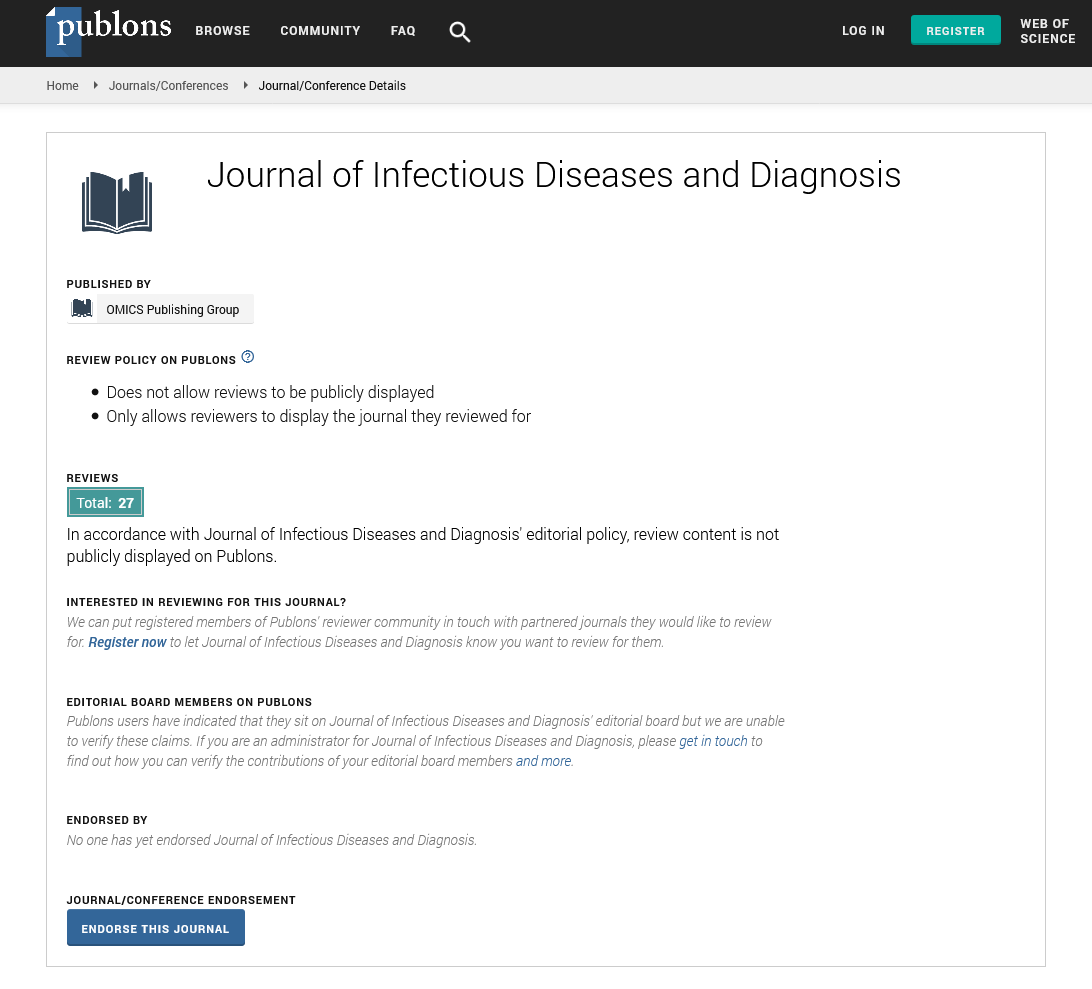Indexed In
- RefSeek
- Hamdard University
- EBSCO A-Z
- Publons
- Euro Pub
- Google Scholar
Useful Links
Share This Page
Journal Flyer

Open Access Journals
- Agri and Aquaculture
- Biochemistry
- Bioinformatics & Systems Biology
- Business & Management
- Chemistry
- Clinical Sciences
- Engineering
- Food & Nutrition
- General Science
- Genetics & Molecular Biology
- Immunology & Microbiology
- Medical Sciences
- Neuroscience & Psychology
- Nursing & Health Care
- Pharmaceutical Sciences
Perspective - (2025) Volume 10, Issue 2
A Global Health Challenge: Exploring the Spread, Impact and Management of Influenza
Peter Nicholas*Received: 25-Feb-2025, Manuscript No. JIDD-25-28669; Editor assigned: 27-Feb-2025, Pre QC No. JIDD-25-28669 (PQ); Reviewed: 14-Mar-2025, QC No. JIDD-25-28669; Revised: 21-Mar-2025, Manuscript No. JIDD-25-28669 (R); Published: 28-Mar-2025, DOI: 10.35248/2576-389X.25.10.323
Description
Influenza, commonly referred to as the flu, is a contagious respiratory illness caused by influenza viruses. It affects millions of people worldwide each year and can range in severity from mild illness to severe complications, especially in vulnerable populations such as the elderly, young children and individuals with pre-existing medical conditions. Seasonal outbreaks and the potential for pandemics make influenza an ongoing concern for global health authorities.
Types and transmission
Influenza viruses are divided into four main types: A, B, C and D. Types A and B are responsible for the majority of seasonal flu outbreaks in humans. Type C causes milder illness and is less commonly reported, while Type D primarily affects cattle and does not infect humans.
Influenza spreads mainly through respiratory droplets when an infected person coughs, sneezes, or talks. It can also spread by touching contaminated surfaces and then touching the mouth, nose, or eyes. The virus has an incubation period of one to four days and infected individuals can transmit the virus even before symptoms appear.
Symptoms and complications
The flu typically begins suddenly and is characterized by symptoms such as fever, chills, muscle aches, fatigue, cough, sore throat and runny nose. Some individuals may also experience vomiting or diarrhoea, although these are more common in children than in adults.
While most healthy individuals recover within a week or two, influenza can lead to serious complications. These include pneumonia, bronchitis, sinus infections and worsening of chronic health issues like asthma or heart disease. In severe cases, influenza can result in hospitalization or death, particularly among high-risk groups.
Diagnosis and treatment
Clinical diagnosis of influenza is often based on symptoms, particularly during the flu season. Laboratory tests, including Rapid Influenza Diagnostic Tests (RIDTs) and Reverse Transcription Polymerase Chain Reaction (RT-PCR), can confirm the presence of the virus. RT-PCR is more accurate but may take longer to deliver results.
Antiviral medications, such as oseltamivir (Tamiflu) and zanamivir (Relenza), can reduce the duration and severity of symptoms if administered early in the course of the illness preferably within 48 hours of symptom onset. These medications can also be used prophylactically in certain situations, such as during outbreaks in long-term care facilities.
Prevention strategies
Annual influenza vaccination remains the most effective method of prevention. Each year, health authorities develop vaccines that target the most likely circulating strains based on global surveillance data. The composition of the vaccine changes annually due to the virus's ability to mutate frequently a phenomenon known as antigenic drift.
In addition to vaccination, other preventive measures include frequent handwashing, avoiding close contact with sick individuals, covering coughs and sneezes and staying home when experiencing flu-like symptoms. These practices are particularly important in settings such as schools, workplaces and healthcare facilities, where the virus can spread quickly.
Global surveillance and response
The World Health Organization (WHO) coordinates global surveillance through the Global Influenza Surveillance and Response System (GISRS). This network monitors flu activity year-round and provides data that inform vaccine composition and public health responses. Collaborative efforts between countries and international health organizations are essential for early detection and control of outbreaks.
Seasonal flu activity varies by region. In temperate climates, flu seasons typically occur during winter months, while tropical regions may experience flu activity year-round, with peaks during rainy seasons. Monitoring these trends helps guide vaccination campaigns and resource allocation.
Influenza pandemics
Unlike seasonal influenza, pandemics occur when a new strain of the virus emerges to which most of the population has little or no immunity. These events can lead to widespread illness and strain on healthcare systems. Pandemic preparedness includes developing rapid diagnostic tools, maintaining stockpiles of antiviral drugs and coordinating international responses. Continued research into universal flu vaccines designed to protect against multiple strains also plays a part in improving long-term influenza control.
The role of public awareness
Public education is essential in managing the spread of influenza. Campaigns that encourage vaccination, personal hygiene and timely medical consultation help reduce transmission. Media platforms, healthcare providers and community leaders all play roles in delivering accurate information and addressing vaccine hesitancy.
In addition, improving access to healthcare and ensuring the availability of vaccines and treatments in low-income regions are necessary steps in reducing the global burden of influenza. Equity in public health response ensures that all populations have the means to protect themselves and recover from illness effectively.
Conclusion
Influenza remains a significant cause of illness and death worldwide, despite decades of research and prevention efforts. Its ability to mutate and adapt challenges scientists and health systems alike. While vaccines, antiviral medications and preventive measures provide valuable tools in the fight against influenza, continued vigilance, innovation and international cooperation are necessary to manage both seasonal outbreaks and potential pandemics in the years to come.
Citation: Nicholas P (2025). A Global Health Challenge: Exploring the Spread, Impact and Management of Influenza. J Infect Dis Diagn. 10:323.
Copyright: © 2025 Nicholas P. This is an open-access article distributed under the terms of the Creative Commons Attribution License, which permits unrestricted use, distribution and reproduction in any medium, provided the original author and source are credited.

